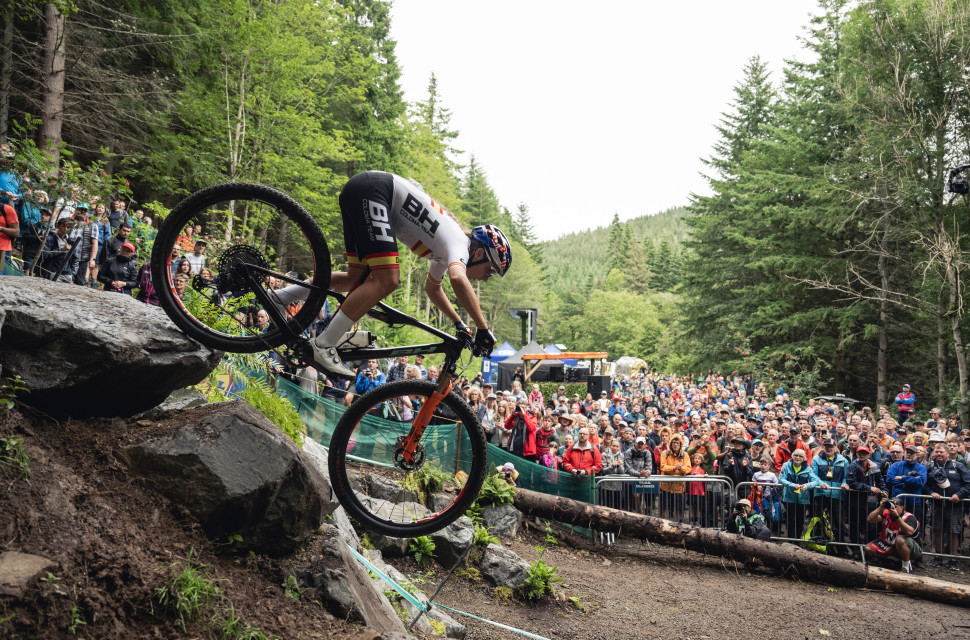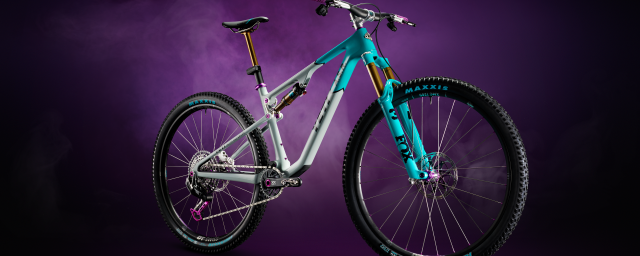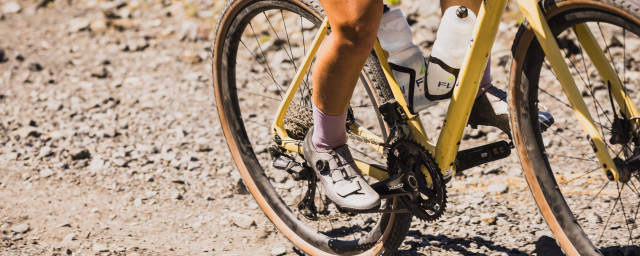Do technical courses make for better cross-country MTB racing?

We’ve heard it time and time again from both brands and the racers themselves, cross-country mountain biking tracks are getting more demanding and more technical. But after watching Tom Pidcock’s legendary XCO World Championship win, it got me thinking: does the increasing challenge of XC race tracks actually lead to good racing?
It’s a phenomenon that we’ve seen happen over the past few years, where cross-country tracks have gotten more mental. To the point where the circuit picked for Scotland’s World Championship XCO included almost everything mountain biking as a sport can throw at a racer. That track included brutal climbs, flowy bike park sections, and that infamous rock roll. That’s without mentioning that Scotland’s race was the first time an actual gap jump was included on a World Championship XCO course.
What this is doing is showcasing the pure skills that these riders possess, as they haul their featherweight, narrow- tyred and comparatively conservatively shaped bikes through and over obstacles that we mere mortals wouldn’t even consider doing on anything with less than 150mm of travel.
Longer, slacker and lower is happening for a reason
These days the average rider wouldn't consider taking on these tracks with anything smaller than a trail bike – and this mindset is showing in the progressive design of cross-country bikes. Cross-country mountain bikes are now experiencing a renaissance of the long, slack and low mindset, where some bikes are now taking the form of trail bikes from a couple of years ago.
Where tracks are getting steeper, slacker head angles offer support and where they're getting faster, longer reaches and wheelbases offer stability. And of course, some sections of Scotland's XCO track were actual sections of bike park, so it goes without saying that cross-country bikes need to suit the riding they're expected of.
Where technical features don't add to the racing
However, as Scotland’s hosting of the XCO World Champs showed, racers aren’t making overtakes in these sections. Taking that rock roll, for example, the A-line riders would sensibly slow their speed in order to take it on without binning it. That lead to something of a bottleneck and, even then, very few riders would take the B-line.
Then the jumps, while an impressive feat to master even on modern XC bikes, they didn’t really add any loss or gain at the highest levels of the sport. Though sections that were rife with line choice seemed to offer an effect similar to DRS in Formula One, where if the rider was taking the quickest and most effective line, that would get them close enough to the rear wheel of the rider ahead. This was used to help make an attack at the next climb, where the most overtaking took place.
Funnily enough, what the riders were struggling with the most were the most unintimidating features of the whole course, the corners. Van der Poel slipped a front wheel on the penultimate corner at the end of the starting lap and there were a few others who did similar on a number of berms around the course. However, were those crashes down to fatigue? As we know, Van der Poel came into this particular race with an existing ankle injury and other spills took place later in the race.
If we compare that to the Downhill World Champs, for example, a genre of racing that revolves around technical features and how best to navigate it to get to the bottom as quickly as possible, any gain in time is clearly visible through a rider's body language as they skip over a rock garden, for example. Spectators can easily see where time is gained, and lost, and where the simplest of mistakes can be costly to the whole run. Though, this is a very stark observation of how different these two sports are and I'll admit, jumps in downhill don't add much to the timing sheets.
Where technical features do add to the racing
It goes without saying that most of the overtakes made during an XC event are on the ascents, where nothing but raw power and all-out commitment reign supreme. That said, when it comes to cross-country racing skills, technical features are a leveller without question.
Technical sections aren't exactly about overtaking opportunities. Nope – they're more about creating them after the next corner or during the next climb. While tackling tech and trying to be competitive, riders must hang on to the rear wheel of the rider in front in order to create an opportunity. If a tailing rider wasn't quite as confident hitting a gap or holding the fastest line, any chance of making an overtake begins to dwindle.
While riders in Scotland's race seemed to have no issues with one of the most progressive World Championship tracks we've seen to date, there is still a bit of that trait that makes downhill mountain biking exciting as a spectator sport. Where some riders can master technical sections more confidently than others.
Are you not entertained?
But at the end of the day, where cross-country is now the most watched form of mountain bike racing, event organisers need to give fans a spectacle. Something for them to want to put the money down for tickets and something to come and witness and enjoy. And as I mentioned a little earlier, it was impressive to see these riders master such technical features. They add another level of fear and uncertainty to a rider’s mindset which is proof of why they are some of the best on the planet. They’re able to tackle such features while redlining almost everywhere on the track and continue to do so eight laps in.
The features also build hype and, I won’t lie, it worked on me. All over Instagram and social media were pictures of that rock roll and riders confidently cleared the gaps. With the knowledge that XC tracks are getting more demanding, this was proof and it got me even more excited to check out the racing.
So, while the big technical features that we saw during this weekend’s XCO World Champs might not have added much to the actual racing, it’s the show, the pageantry and the inspiration where it’s really important. The entertainment value which Scotland delivered in spades. The ever-increasing rigours that modern XC courses pose are not only a natural progression of the sport, but it adds entertainment value that's hard to beat.















